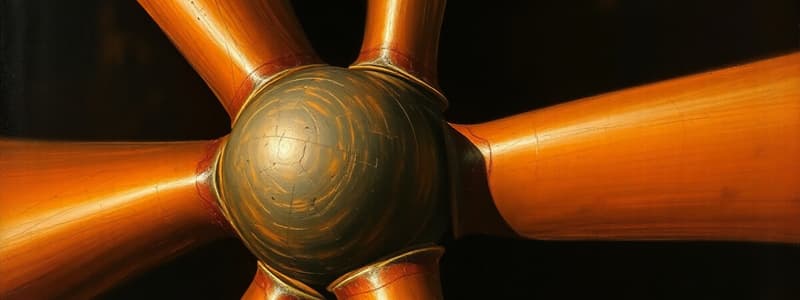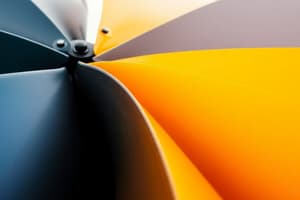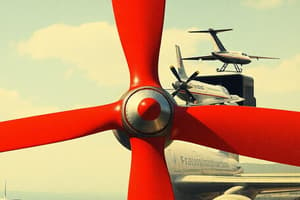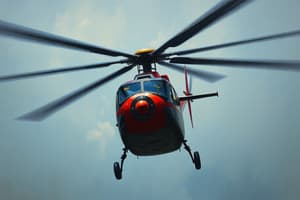Podcast
Questions and Answers
What is the main advantage of metal blades?
What is the main advantage of metal blades?
- Metal blades are more efficient in terms of weight and performance. (correct)
- Metal blades are cheaper to produce than wooden blades.
- Metal blades are easier to repair and maintain than wooden blades.
- Metal blades are generally stronger and more durable than wooden blades.
What is the purpose of the stainless steel cap on the leading edge of a wooden rotor blade?
What is the purpose of the stainless steel cap on the leading edge of a wooden rotor blade?
- To increase the overall weight of the blade.
- To improve aerodynamic performance.
- To protect the leading edge from damage during flight. (correct)
- To reduce noise during flight.
What is a significant disadvantage of wooden rotor blades?
What is a significant disadvantage of wooden rotor blades?
- Wooden blades are more susceptible to damage from moisture than metal blades. (correct)
- Wooden blades are less efficient in terms of aerodynamic performance than metal blades.
- Wooden blades are more difficult to manufacture than metal blades.
- Wooden blades are heavier than metal blades.
What is the purpose of the aluminum pockets on the trailing edge of a metal rotor blade?
What is the purpose of the aluminum pockets on the trailing edge of a metal rotor blade?
How are metal rotor blades typically attached to the rotor head?
How are metal rotor blades typically attached to the rotor head?
What is the purpose of the stainless steel abrasion strip on a metal rotor blade?
What is the purpose of the stainless steel abrasion strip on a metal rotor blade?
What should be done with a rotor blade that has sustained nonrepairable damage?
What should be done with a rotor blade that has sustained nonrepairable damage?
Why must wooden rotor blades be paired?
Why must wooden rotor blades be paired?
Which of the following should be protected with a light coating of corrosion preventive?
Which of the following should be protected with a light coating of corrosion preventive?
Which of the following is NOT a common feature of both wooden and metal rotor blades?
Which of the following is NOT a common feature of both wooden and metal rotor blades?
Where should the manufacturer's blade records be placed?
Where should the manufacturer's blade records be placed?
What should be done to the container before storing the blade?
What should be done to the container before storing the blade?
How should the blade be secured when packaging?
How should the blade be secured when packaging?
What is the primary function of tail rotor blades?
What is the primary function of tail rotor blades?
What materials are used to construct tail rotor blades?
What materials are used to construct tail rotor blades?
Which type of material is commonly used for spars in metal tail rotor blades?
Which type of material is commonly used for spars in metal tail rotor blades?
What is used to support the blade skins on the inside of metal tail rotor blades?
What is used to support the blade skins on the inside of metal tail rotor blades?
How are the blade skins of fiberglass tail rotor blades supported?
How are the blade skins of fiberglass tail rotor blades supported?
What method is sometimes used to achieve spanwise balance on tail rotor blades?
What method is sometimes used to achieve spanwise balance on tail rotor blades?
How is chordwise balance achieved on some tail rotor blades?
How is chordwise balance achieved on some tail rotor blades?
What does the process of trammeling involve?
What does the process of trammeling involve?
When moving the span-wise weight is permitted, what is the repairer's task?
When moving the span-wise weight is permitted, what is the repairer's task?
What is the primary goal of tracking a helicopter blade?
What is the primary goal of tracking a helicopter blade?
What can happen if helicopter blades do not track correctly?
What can happen if helicopter blades do not track correctly?
Adding or removing tracking weights affects the blade track by:
Adding or removing tracking weights affects the blade track by:
What is the primary function of trim tabs on helicopter blades?
What is the primary function of trim tabs on helicopter blades?
Why are trim tabs typically located near the blade tip?
Why are trim tabs typically located near the blade tip?
How are trim tabs adjusted to achieve proper blade tracking?
How are trim tabs adjusted to achieve proper blade tracking?
What is the primary benefit of using trim tabs instead of tracking weights?
What is the primary benefit of using trim tabs instead of tracking weights?
What is the primary purpose of the spar in a rotor blade?
What is the primary purpose of the spar in a rotor blade?
How is the chord of a rotor blade defined?
How is the chord of a rotor blade defined?
What characterizes chordwise damage to a rotor blade?
What characterizes chordwise damage to a rotor blade?
Which statement is true about doublers in rotor blades?
Which statement is true about doublers in rotor blades?
What is the top side of a rotor blade typically referred to as?
What is the top side of a rotor blade typically referred to as?
What material is generally used to construct the spar of a rotor blade?
What material is generally used to construct the spar of a rotor blade?
What does the chord line of a rotor blade represent?
What does the chord line of a rotor blade represent?
In rotor blade terminology, what is the bottom side referred to as?
In rotor blade terminology, what is the bottom side referred to as?
What is the primary reason for bonding in blade construction?
What is the primary reason for bonding in blade construction?
What must manufacturers avoid when drilling in load-carrying parts of the blade?
What must manufacturers avoid when drilling in load-carrying parts of the blade?
What effect do paint thinners and cleaning solvents have on bonded joints?
What effect do paint thinners and cleaning solvents have on bonded joints?
Where is the faying surface located?
Where is the faying surface located?
Which type of weight is placed into the leading edge of a blade during manufacture?
Which type of weight is placed into the leading edge of a blade during manufacture?
What must a repairer remember if moving weight in helicopter blades?
What must a repairer remember if moving weight in helicopter blades?
Where are spanwise balance weights typically located on a blade?
Where are spanwise balance weights typically located on a blade?
What happens when spanwise weight is added to the blade?
What happens when spanwise weight is added to the blade?
Flashcards
Rotor Blade Chord
Rotor Blade Chord
The width of the blade measured at its widest point.
Rotor Blade Chord Line
Rotor Blade Chord Line
An imaginary line through the center of the blade from the leading edge to the trailing edge.
Rotor Blade Spar
Rotor Blade Spar
The main supporting structure of a rotor blade, running along the span line.
Rotor Blade Doublers
Rotor Blade Doublers
Signup and view all the flashcards
Rotor Blade Top
Rotor Blade Top
Signup and view all the flashcards
Rotor Blade Bottom
Rotor Blade Bottom
Signup and view all the flashcards
Spanwise Damage
Spanwise Damage
Signup and view all the flashcards
Chordwise Damage
Chordwise Damage
Signup and view all the flashcards
Bonding
Bonding
Signup and view all the flashcards
Faying Surfaces
Faying Surfaces
Signup and view all the flashcards
Hole Drilling in Blades
Hole Drilling in Blades
Signup and view all the flashcards
Spanwise Balance
Spanwise Balance
Signup and view all the flashcards
Chordwise Balance
Chordwise Balance
Signup and view all the flashcards
Tracking Balance
Tracking Balance
Signup and view all the flashcards
Spanwise Balance Weights
Spanwise Balance Weights
Signup and view all the flashcards
Mass Balance Weights
Mass Balance Weights
Signup and view all the flashcards
Fiberglass Rotor Blade
Fiberglass Rotor Blade
Signup and view all the flashcards
Stainless Steel Cap on Wood Rotor Blade
Stainless Steel Cap on Wood Rotor Blade
Signup and view all the flashcards
Matched Pairs for Wood Blades
Matched Pairs for Wood Blades
Signup and view all the flashcards
Moisture Impact on Wood Blades
Moisture Impact on Wood Blades
Signup and view all the flashcards
Aluminum Rotor Blade Design
Aluminum Rotor Blade Design
Signup and view all the flashcards
Quality Control in Metal Blades
Quality Control in Metal Blades
Signup and view all the flashcards
Individual Replacement of Metal Blades
Individual Replacement of Metal Blades
Signup and view all the flashcards
Life Limit for Metal Blades
Life Limit for Metal Blades
Signup and view all the flashcards
Center of Gravity Blade Adjustment
Center of Gravity Blade Adjustment
Signup and view all the flashcards
Blade Tracking Adjustment
Blade Tracking Adjustment
Signup and view all the flashcards
Tracking Weights
Tracking Weights
Signup and view all the flashcards
Feathering Axis
Feathering Axis
Signup and view all the flashcards
Plane of Rotation
Plane of Rotation
Signup and view all the flashcards
Trim Tab
Trim Tab
Signup and view all the flashcards
Rotor Blade Tracking
Rotor Blade Tracking
Signup and view all the flashcards
Why Is Blade Tracking Important?
Why Is Blade Tracking Important?
Signup and view all the flashcards
Rotor Blade Preservation and Storage
Rotor Blade Preservation and Storage
Signup and view all the flashcards
Outboard Eroded Surfaces
Outboard Eroded Surfaces
Signup and view all the flashcards
Foreign Object Damage (FOD)
Foreign Object Damage (FOD)
Signup and view all the flashcards
Main Bolt Hole Bushing, Drag Brace Retention Bolt Hole Bushing
Main Bolt Hole Bushing, Drag Brace Retention Bolt Hole Bushing
Signup and view all the flashcards
National Stock Number (NSN)
National Stock Number (NSN)
Signup and view all the flashcards
What is the function of tail rotor blades?
What is the function of tail rotor blades?
Signup and view all the flashcards
What materials are used for tail rotor blades?
What materials are used for tail rotor blades?
Signup and view all the flashcards
How are metal tail rotor blades supported?
How are metal tail rotor blades supported?
Signup and view all the flashcards
How are fiberglass tail rotor blades supported?
How are fiberglass tail rotor blades supported?
Signup and view all the flashcards
What is spanwise balance in tail rotor blades?
What is spanwise balance in tail rotor blades?
Signup and view all the flashcards
What is chordwise balance in tail rotor blades?
What is chordwise balance in tail rotor blades?
Signup and view all the flashcards
What is trammeling in tail rotor systems?
What is trammeling in tail rotor systems?
Signup and view all the flashcards
Why is blade balance important?
Why is blade balance important?
Signup and view all the flashcards
Study Notes
Rotary Wing Aerodynamics
- Rotor blades are designed as symmetrical airfoils to create a stable aerodynamic pitching characteristic.
- Aerodynamic stability is achieved when the center of gravity, center of pressure, and blade-feathering axis are aligned at the same point.
- This alignment ensures the blade remains stable during pitch changes.
Rotor Blades - Design and Construction
- Rotor blade design and construction vary among manufacturers, though all aim to create the most efficient and economical lifting device.
- Helicopter design requirements influence rotor blade design and construction.
Rotor Blades - Materials
- Common materials for rotor blades include aluminum, steel, brass, and fiberglass.
- Early rotor blades were often made of wood.
- Metal blades followed, then composite blades using various materials as the newest blade design.
Wooden Rotor Blades
- First production rotor blades were laminated wood (birch, spruce, pine, and balsa).
- A steel core was placed near the leading edge of the blade for increased strength.
- The exterior surface was covered with resin-impregnated fiberglass cloth.
- Two-thirds of the blade's outboard leading edge portion is often protected with stainless steel.
- Blades are typically manufactured in matched pairs.
Metal Rotor Blades (Aluminum)
- Metal blades have been in production for over 40 years.
- Construction varies widely due to manufacturing expense and different manufacturers.
- A typical metal blade has a hollow, extruded aluminum spar that forms the leading edge.
- Quality control is a key advantage of this construction.
Metal Blades - Design Features
- Single blades can be exchanged without needing matched sets.
- Aluminum pockets on the trailing edge of the spar improve the blade's streamlining.
- An aluminum tip cap, secured via screws, improves streamlining and aids in bonding.
- Like other metals, blade life is limited due to stress during flight.
Composite Rotor Blades
- Fiberglass or composite blades are load-bearing components, either using fiberglass or metal spars.
- Roving's, which are strips of glass, make up the spar and are impregnated with epoxy resin.
- The roving materials are wrapped around a foam core, and fiberglass cloth creates the blade's skin.
- Root reinforcement plates are frequently added to the blade.
- The leading edge is often covered with a stainless steel strip.
Rotor Blades - Internal Structural Components
- Rotor blades typically have ribs, I-beams, and spanwise channels to support the blade skin.
- Aluminum honeycomb foil is another common supporting structural element.
Blade Nomenclature
- The Blade Planform is the overall shape viewed from above, either uniform or tapered.
- Uniform planforms are more common as they are simpler to manufacture.
Blade Construction- Single Pocket/Fairing
- Single-pocket blades have a one-piece skin on both top and bottom that extends across the entire span and chord, positioned behind the spar.
- This design is relatively simple and easier to construct because it has a minimum number of pockets.
Blade Construction-Multiple Pockets/Fairings
- Multiple-pocket blades are more costly, but pockets are simpler to replace if damaged, making repeated use possible.
- This construction approach is more flexible overall
- Blade pockets or fairings, coated with fiberglass, provide support
Blade Construction - Bonds and Bonding
- Bonding joins multiple parts using adhesive compounds.
- Using bonding is less expensive than other construction types, such as using rivets or screws.
- Manufacturers avoid drilling holes, except at blade ends, to aid in overall structural strength.
Rotor Blade Preservation and Storage
- Condemn and dispose of damaged blades.
- Repair or seal any holes to prevent moisture and corrosion.
- Remove all foreign matter with soap and water.
- Protect any bare or exposed metal with corrosion-resistant coating.
- Secure blades within shock-mounted supports when packaging and storing them.
- Record required information on the container, such as the blade's NSN, model, and serial number.
Blade Balance
- Balancing methods include chordwise, spanwise, or tracking weights.
- These are often added to the leading edge to ensure proper balance.
Blade Construction - Trim Tabs
- These tab adjustments allow controllers to position the rotor blades on a similar plane for flight.
Blade Construction- Tail Rotor Blades
- Tail rotor blades primarily provide directional control—not lift.
- Metal or fiberglass, and they are generally made using a similar method to main rotor blades, extrusions, and sheet channels.
Blade Construction -Fiberglass Blades, Metal Blades
- The blade skin for metal blades is formed around the spar and is bonded to the inside.
- Larger blades often have internal supporting structures (aluminum honeycomb and ribs) for reinforced support.
- Smaller blades may not have internal reinforcement.
- Fiberglass blade skins are formed around and bonded to H-shaped titanium spars, further reinforced by aluminum honeycomb.
Blade Construction - Blade Construction (Figures 3-10, 3-16)
- The mast is station zero, which is referred to in diagrams for balance points during manufacturing.
Blade Balance-Spanwise, Trammeling
- Adding or subtracting washers on the blade tip allows for spanwise balance.
- Other models add the corresponding weights in the cuff attachment bolts.
- Also, weights can be added or removed at the spanwise balance bolts
- Fully articulated tail rotor systems must be trammeled before balancing.
- Trammeling involves aligning the tail rotor blades equally, leading to a 2º lead angle.
Blade Construction (Figures 3-18, 3-20, 3-21, 3-22)
- The repairer must understand that changing weights changes the center of gravity.
- Adding/subtracting weight has the effect of moving the center of gravity.
- Spanwise weights are at the blade tip for attaching to the spar.
- Weights applied at different locations impact the rotor's stability.
Blade Construction - Blade Construction (Figures 3-23, 3-24)
- Attaching weights in front of and behind a blade's feathering axis will help the blade track evenly.
- Tracking weights can be shifted to adjust the orientation of the blade in the plane of rotation.
- Trim tabs allow for the blade to be moved relative to its initial position, and to alter the leading edge's flying position up or down relative to the baseline.
Rotor Blade Construction - General
- All blades require a specific build and tracking orientation in the plane of rotation.
- Failure to meet this specification leads to various issues and problems, both structurally and practically affecting flight.
Studying That Suits You
Use AI to generate personalized quizzes and flashcards to suit your learning preferences.




